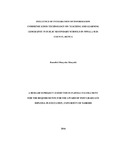| dc.contributor.author | Musyoki, Benedict, M | |
| dc.date.accessioned | 2016-11-15T06:54:52Z | |
| dc.date.available | 2016-11-15T06:54:52Z | |
| dc.date.issued | 2016 | |
| dc.identifier.uri | http://hdl.handle.net/11295/97205 | |
| dc.description.abstract | We are living in the digital age and hardly any aspect of human endeavour can be
effectively carried on without Information communication technologies (ICTs)
including education. ICTs are now at the center of education reform in line with
the technological development of the 21st century. ICT-supported education can
promote the acquisition of the knowledge and skills that will empower students
for lifelong learning. Although schools have had computers for almost two
decades, ways to use them effectively have evolved slowly and patchily.
Technological revolution in schools has been beset by theoretical inadequacies
that have kept educational technology at the margins of the established
educational system. This creates a digital divide between the developed countries
and the developing countries in relation to integration of ICTs in teaching and
learning geography. The study was done in secondary schools in Mwala Sub-
County; to assess the ICT facilities and infrastructure; to determine the teacher’s
ICT knowledge and skills in application of ICT; to establish how the schools get
the ICT technical support in and to establish the school administrative practice
that influences the use of ICT in teaching and learning geography in secondary
schools. Non-experimental descriptive survey design was used to establish the
factors that influence the integration and the use of ICTs in teaching and learning
geography in secondary schools in Mwala Sub- County. There are 75 secondary
schools that made up the target population. A sample of twelve schools which-
30% of the total population was used in the study. Stratified random was used to
allow full participation of the schools. There are 463 teachers in secondary
schools that make up the target population. Four teachers were randomly sampled
in each sample school to fill the questionnaire and twenty three principals were
interviewed to represent each category of schools. Questionnaires, observation
schedule and interview enabled the researcher collect data. Piloting was done in
two schools to test the reliability and validity of the research instruments. The
data collected was analyzed using statistical package for social sciences (SPSS).
Descriptive statistics was used to present the results of the study and the general
trends; this involved tabulating, graphing and describing data. This was followed
by a discussion of the finding, drawing conclusions and giving recommendations
based on the finding in the study. The study finding revealed that inadequate ICT
infrastructure, limited ICT skills and training, limited access to technical support,
lack of ICT policies in school and budget constraints hinder the integration of ICT
in teaching and learning geography in secondary schools. The researcher
recommends that the school administration familiarize themselves with the
national ICT policy so that they can develop school ICT policies of how to
efficiently integrate ICTs in teaching and learning geography. The government
should also intensify ICT funding in schools to help subsidize the high ICT costs
and increase the number of computers in schools. Teacher training programmes
should factor in ICT units to enhance ICT skills in teaching and learning
geography. | en_US |
| dc.language.iso | en | en_US |
| dc.publisher | University of Nairobi | en_US |
| dc.rights | Attribution-NonCommercial-NoDerivs 3.0 United States | * |
| dc.rights.uri | http://creativecommons.org/licenses/by-nc-nd/3.0/us/ | * |
| dc.subject | Influence of Integration of Information Communication Technology | en_US |
| dc.title | Influence of Integration of Information Communication Technology on Teaching and Learning Geography in Public Secondary Schools in Mwala Subcounty, Kenya | en_US |
| dc.type | Thesis | en_US |



